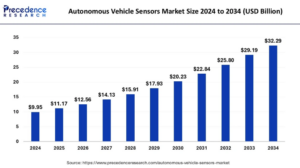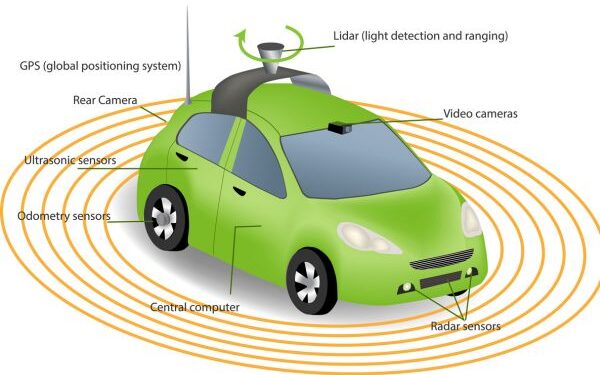The global autonomous vehicle sensors market size is expected to reach around USD 32.29 billion by 2034 from USD 9.95 billion in 2024 with a CAGR of 12.49%.

The autonomous vehicle sensors market is rapidly expanding as self-driving technology advances. Sensors such as LiDAR, RADAR, cameras, and ultrasonic sensors play a crucial role in enabling autonomous vehicles to perceive their environment, detect obstacles, and make real-time driving decisions. Increasing demand for advanced driver assistance systems (ADAS) and fully autonomous vehicles is fuelling market growth.
Autonomous Vehicle Sensors Market Key Insights
- By sensor type, the LiDAR segment accounted for the largest market share in 2024.
- By vehicle type, the passenger vehicle segment is projected to secure a significant market share during the forecast period.
- By level of automation, the Level 3 segment is anticipated to hold a substantial market share throughout the forecast period.
- By application, the obstacle detection segment dominated the market in 2024.
- By region, Europe is expected to maintain a prominent market share during the forecast period.
Autonomous Vehicle Sensors: Overview and Importance
Autonomous vehicle sensors are critical components that enable self-driving cars to perceive their surroundings, interpret data, and make real-time driving decisions. These sensors work together using AI and sensor fusion technology to create a comprehensive understanding of the environment, ensuring safe and efficient autonomous navigation.
Types of Autonomous Vehicle Sensors
LiDAR (Light Detection and Ranging)
- Uses laser beams to create a 3D map of the surroundings.
- Essential for precise object detection, distance measurement, and depth perception.
- Provides high accuracy but is expensive and affected by weather conditions.
RADAR (Radio Detection and Ranging)
- Uses radio waves to detect objects, their speed, and distance.
- Works well in all weather conditions, making it reliable for autonomous vehicles.
- Commonly used for adaptive cruise control and collision avoidance.
Cameras
- Capture real-time images and video to identify objects, lane markings, and traffic signs.
- Used for machine vision and deep learning-based decision-making.
- Limited by lighting conditions and requires AI-based image processing.
Ultrasonic Sensors
- Short-range sensors used for parking assistance and low-speed manoeuvring.
- Detect objects close to the vehicle, such as curbs and pedestrians.
- Work best in slow-speed applications but have a limited detection range.
Inertial Measurement Unit (IMU)
- Measures acceleration, orientation, and velocity changes.
- Helps in stabilizing the vehicle and maintaining balance during motion.
Role of Sensors in Autonomous Driving
- Obstacle detection and collision avoidance.
- Lane-keeping and road sign recognition.
- Adaptive cruise control and autonomous parking.
- Navigation and localization through mapping and GPS integration.
The Role of AI in the Autonomous Vehicle Sensors Market
AI plays a critical role in the autonomous vehicle sensors market by enabling advanced sensor fusion and real-time decision-making. By combining data from various sensors such as LiDAR, RADAR, and cameras, AI algorithms process and interpret complex information to help autonomous vehicles understand their surroundings. This integration allows for accurate object detection, obstacle avoidance, and adaptive navigation, ensuring that vehicles can safely and efficiently operate without human intervention.
Machine learning models continuously improve as they learn from vast amounts of data, enhancing the vehicle’s ability to make intelligent decisions in real-world driving conditions.
AI also helps optimize the performance of sensors by compensating for their limitations. For instance, AI-powered vision systems can enhance the capabilities of cameras in challenging environments like low light or bad weather. Additionally, AI assists in predictive maintenance by analysing sensor data to detect potential issues, reducing downtime and increasing the reliability of autonomous vehicles.
As the technology advances, AI’s role in refining sensor systems will continue to be a driving force in the growth of the autonomous vehicle sensors market.
Market Drivers
The market is driven by rising investments in autonomous vehicle technology, increasing demand for road safety, and regulatory support for self-driving cars. Advancements in AI and sensor fusion are enhancing the accuracy and reliability of perception systems. Growing adoption of electric vehicles further accelerates sensor integration in autonomous driving systems.
Opportunities
Expanding smart city projects, 5G connectivity, and the rise of vehicle-to-everything (V2X) communication present significant opportunities. The development of high-resolution LiDAR and AI-powered vision systems is improving sensor efficiency, opening new possibilities for fully autonomous transportation. Additionally, increased demand for ADAS in conventional vehicles is boosting sensor adoption.
Challenges
High sensor costs, technical limitations in adverse weather conditions, and challenges in integrating multiple sensors for real-time decision-making remain key hurdles. Regulatory uncertainties and cybersecurity threats pose risks to market growth. Additionally, the complexity of data processing in autonomous vehicles requires further advancements in AI and computing power.
Regional Insights
North America leads the market due to strong investment in self-driving technology and the presence of major autonomous vehicle manufacturers. Europe follows with stringent safety regulations and increasing deployment of ADAS-equipped vehicles. The Asia-Pacific region is witnessing rapid growth, driven by the expansion of electric vehicles, government initiatives, and advancements in smart mobility infrastructure.
Type of Sensor Insights
The LiDAR segment dominated the autonomous vehicle sensors market in 2024. LiDAR sensors provide high-resolution, 3D mapping of the environment, helping autonomous vehicles detect objects and navigate complex scenarios with precision.
LiDAR is often used alongside radar and cameras to improve reliability and safety. This redundancy allows autonomous vehicles to cross-verify data from multiple sources, enhancing object detection and avoidance. The increasing launch of new LiDAR products is further driving market growth.
Vehicle Type Insights
The passenger vehicle segment is expected to hold a significant market share during the forecast period. Rising consumer demand for advanced driving features is fuelling this growth.
Autonomous vehicle sensors enable features like parking assistance, collision avoidance, and semi-autonomous driving. These technologies enhance the driving experience and improve road safety, increasing their adoption in passenger vehicles.
Level of Automation Insights
The Level 3 automation segment is projected to see substantial growth. Vehicles with Level 3 autonomy require a combination of advanced sensors, including LiDAR, radar, cameras, and ultrasonic sensors. These sensors allow the vehicle to perceive its surroundings and make driving decisions independently.
Automakers, technology companies, and sensor manufacturers are working together to develop and integrate these technologies. This collaboration is expected to accelerate the adoption of Level 3 autonomous vehicles.
Application Insights
Obstacle detection held the largest market share in 2024. Sensors play a crucial role in identifying obstacles in real time, allowing vehicles to avoid collisions and ensure safety. Regulatory bodies emphasize the importance of obstacle detection in self-driving cars, integrating these technologies into safety regulations.
The navigation segment is also expected to grow rapidly. As cities become more crowded, autonomous vehicles need advanced sensors to navigate urban environments safely. Sophisticated sensor systems help vehicles manage complex traffic patterns and infrastructure challenges.
Autonomous Vehicle Sensors Market Companies
- BorgWarner Inc.
- Fujitsu
- NXP Semiconductors
- Asahi Kasei Corporation
- Lumentum Operations LLC
- Valeo
- Continental AG
- Brigade Electronics
- Navtech Radar
- Teledyne Geospatial
Segments Covered in the Report
By Type of Sensor
- RADAR
- LiDAR
- Ultrasound
- Camera
- Others
By Vehicle Type
- Passenger
- Commercial
By Level of Automation
- Level 1
- Level 2
- Level 3
- Level 4
- Level 5
By Application
- Obstacle Detection
- Navigation
- Collision Avoidance
- Others
By Geography
- North America
- Europe
- Asia-Pacific
- Latin America
- Middle East and Africa








